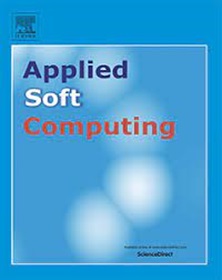Twin-population multiple knowledge-guided transfer prediction framework for evolutionary dynamic multi-objective optimization
IF 7.2
1区 计算机科学
Q1 COMPUTER SCIENCE, ARTIFICIAL INTELLIGENCE
引用次数: 0
Abstract
Dynamic multi-objective evolutionary algorithms (DMOEAs) have been widely studied, and one of the main tasks is the need for algorithms to track Pareto optimal front (POF) under dynamic environmental changes. Existing methods integrate transfer learning (TL) techniques to predict the initial population for the new environment. However, the lack of transferred individual diversity and inaccurate moving directions lead to poor performance of DMOEAs. Therefore, this work proposes a Twin-population Multiple Knowledge-guided Transfer prediction (TMKT) framework to form an initial population for the new environment. Three strategies, i.e., Twin Populations Guided prediction (TPG), SVM-based Multi-knowledge prediction (SVM-M) and Kernel Subspace Alignment for Transfer prediction (KSA-T), are designed to mine and transfer positive historical knowledge for accurately predicting changing POFs. First, TPG is used to obtain new approximate individuals and provide potential directions of subsequent transfer, which splits the population into two twin populations based on upper and lower quartile points of the first objective and their angles. Subpopulations transmit information by different similarity methods to obtain their new positions. Secondly, to obtain solutions with better diversity and convergence, SVM-M trains a certain classifier that can discriminate between positive and negative solutions and predicts labels of noisy solutions based on useful knowledge from the first two environments. Third, KSA-T is proposed to further enhance the accuracy of the new population prediction. The kernel trick and second-order feature alignment are introduced in subspace alignment to develop a new TL technique called Kernel Subspace Alignment (KSA) for adaptively achieving homotypic distributions of the source domain and target domain. Solutions predicted by TPG as the target domain are employed to guide the evolution, and obtained-SVM-M positive solutions are transferred to the new environment via KSA. TMKT is integrated with two baseline algorithms MOEA/D and NSGA-II to construct DMOEAs. Numerical results on 14 functions of different variation types and a real parameter optimization problem of control system validate the superior dynamic optimization performance of TMKT compared with five state-of-the-art algorithms.
进化动态多目标优化的双种群多知识引导迁移预测框架
动态多目标进化算法(dmoea)已经得到了广泛的研究,其中一个主要任务是需要在动态环境变化下跟踪Pareto最优前沿(POF)的算法。现有的方法集成了迁移学习(TL)技术来预测新环境的初始种群。然而,由于迁移个体多样性不足和移动方向不准确,导致dmoea性能不佳。因此,本文提出了一个双种群多知识引导迁移预测(TMKT)框架,为新环境形成初始种群。设计了三种策略,即孪生种群引导预测(TPG)、基于支持向量机的多知识预测(SVM-M)和核子空间对齐转移预测(KSA-T),以挖掘和转移积极的历史知识,以准确预测变化的pof。首先,利用TPG获得新的近似个体,并提供后续迁移的潜在方向,根据第一个目标的上下四分位数及其角度将种群划分为两个双胞胎种群。亚种群通过不同的相似性方法传递信息以获得新的位置。其次,为了获得具有更好多样性和收敛性的解,SVM-M训练了一个分类器,该分类器可以区分正解和负解,并根据前两种环境的有用知识预测有噪声解的标签。第三,提出KSA-T,进一步提高新种群预测的准确性。在子空间对齐中引入核技巧和二阶特征对齐,提出了一种新的TL技术——核子空间对齐(KSA),用于自适应实现源域和目标域的同型分布。利用TPG预测的解作为目标域来引导进化,并将得到的svm - m正解通过KSA转移到新环境中。TMKT与MOEA/D和NSGA-II两种基线算法集成构建dmoea。对14种不同变分类型的函数和控制系统的实际参数优化问题的数值计算结果验证了TMKT算法与5种最先进算法相比具有优越的动态优化性能。
本文章由计算机程序翻译,如有差异,请以英文原文为准。
求助全文
约1分钟内获得全文
求助全文
来源期刊

Applied Soft Computing
工程技术-计算机:跨学科应用
CiteScore
15.80
自引率
6.90%
发文量
874
审稿时长
10.9 months
期刊介绍:
Applied Soft Computing is an international journal promoting an integrated view of soft computing to solve real life problems.The focus is to publish the highest quality research in application and convergence of the areas of Fuzzy Logic, Neural Networks, Evolutionary Computing, Rough Sets and other similar techniques to address real world complexities.
Applied Soft Computing is a rolling publication: articles are published as soon as the editor-in-chief has accepted them. Therefore, the web site will continuously be updated with new articles and the publication time will be short.
 求助内容:
求助内容: 应助结果提醒方式:
应助结果提醒方式:


